check engine CHEVROLET S10 1997 2.G User Guide
[x] Cancel search | Manufacturer: CHEVROLET, Model Year: 1997, Model line: S10, Model: CHEVROLET S10 1997 2.GPages: 402, PDF Size: 21.04 MB
Page 100 of 402
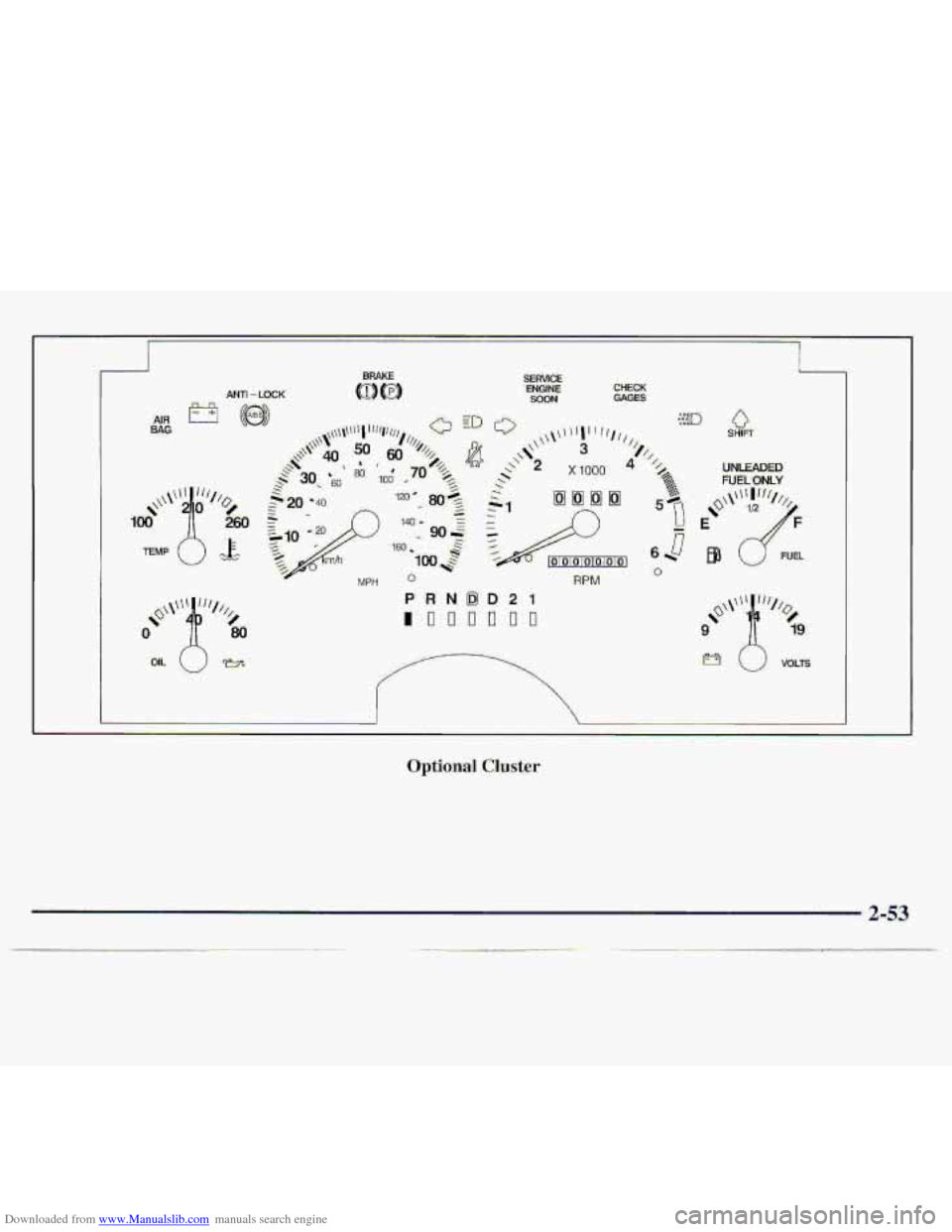
Downloaded from www.Manualslib.com manuals search engine ANTI -LOCK CHECK GAGES
-RPM V
I
I I
Optional Cluster
2-
Page 103 of 402

Downloaded from www.Manualslib.com manuals search engine Air Bag. Readiness-L-ight
There is '.an air hag readines.s light on the instrumen-t
panel, which shows A1R.BA.G. The syste.m checks the.
air.
bag's electrical system for malfunction-s. The light
,tells
.you, if thereis -an ekctrical pmbkm. The system
check
ificlndes .the ak bag sensors, the ,air bag. nzQdule,
the wiring. and the diagnostic module. For- more
infcjrmation on the air bag system, s,ee "Air Bag" in
the
Index.
AIR
BAG
'This, light will come on
when you start your engine,
and it will flash for a few
-seconds. Then the light
:should go Out.. This means
,the system is r"eady.
If-tbe air bag readiness light stays on afterylau start the
efi.gine or c.omes on wh&n you are drivingj. yo.ur air bag
s.ystem may not work properly. Have :your vehicle
serviced right away.
The air bag readiness light sho.uid. flash.for a few
seconds when you turn the. ignition key to RUN. If the
light doesn't come
on. then, have it- fixed SO it will be
ready to warn you if there is a problem.
I--i/
The charging system light
will c.ome on briefly when
you turn on the ignition,
but the engine is not
-running, as- ,a cheek to
show -you it is- working.
1t:should go .out once the engine. is Iuming. If it stays
on, or corms on while you are driving; you may have a
problem with the chargigg system. It c'ould. indicate that
you have problems with a generator ,dsive belt, or
%math& ekctrical probIern. Have it checked right away.
Driving whilethis light is. on could drain ,your b.attery.
If you must drive a short distance. with the light an, be,
certain
to turn. off all your wxssories, .such as the radio
adair conditioner.
Page 107 of 402
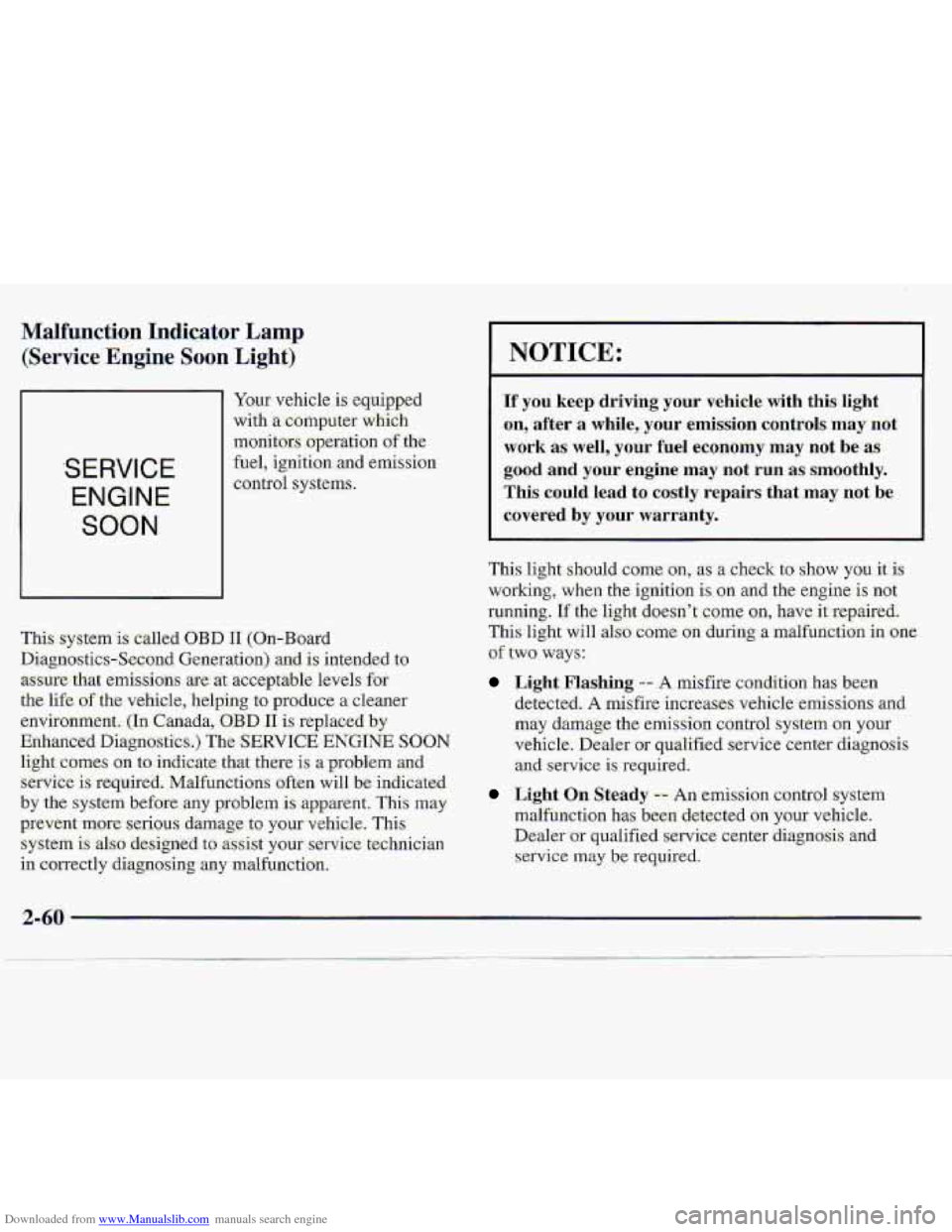
Downloaded from www.Manualslib.com manuals search engine Malfunction Indicator Lamp
(Service Engine Soon Li-ght)'
SERVICE
ENGINE
SOON
Yaw vehicle is eq-uipped
with
a computer which
monitors
.operation of the
fuel, igniti.on and ernis-sion
control systems.
This .system
is called OBD I1 (On-Board
Diagnostics-Second Generation) and. is intended to
.assure that ernisstons are. at acceptable levels,fo.r
the
l-ife of the vehicle, helping to produce a clearier
environment,
(In Canada,:OBD I1 is replaced by
Enhanced Diqgnostics.)
The SERVICE ENGINE SOON
light comes on to indicate that there is a-problem..ancl
service is require-d. Malfunctions often will be indicated
by the system before .any proble,m is apparent. This may
prevent more serious. damage to your vehicle. This
system is al-so designed to assist your servi:ce:technician
in correctly di-agnosing any malfunction.
NOTICE:
If you keep driving your vehicle with this-light
on, ,after
a while,- your ernitision controls may not
work as: well, your fuel economy may not be as-
good and your engine may not run as. smoothly.
This could lead to. costly repairs that may not be
covered by your warranty.
This light should ceme on, as a check to show you it is
working, when the ignition is on and the engine is not
running.
If the light doesn't come an, have-it repaired.
This light will also come on during a malfuncti-on in one
of two ways:
Light Flashing -- A misfire condition has been
detected.
A misfire increases vehicle-emis-sions and
may damage the emission control-system on your
vehicle. Dealer
or qualified service center diagnosis
and service is'required.
L&ht On: Steady -- .An erni,ssion control system
malfunction
has been detected on your vehicle.
Dealer
or qualified service center diagnosis. and
service may b:e required.
Page 110 of 402
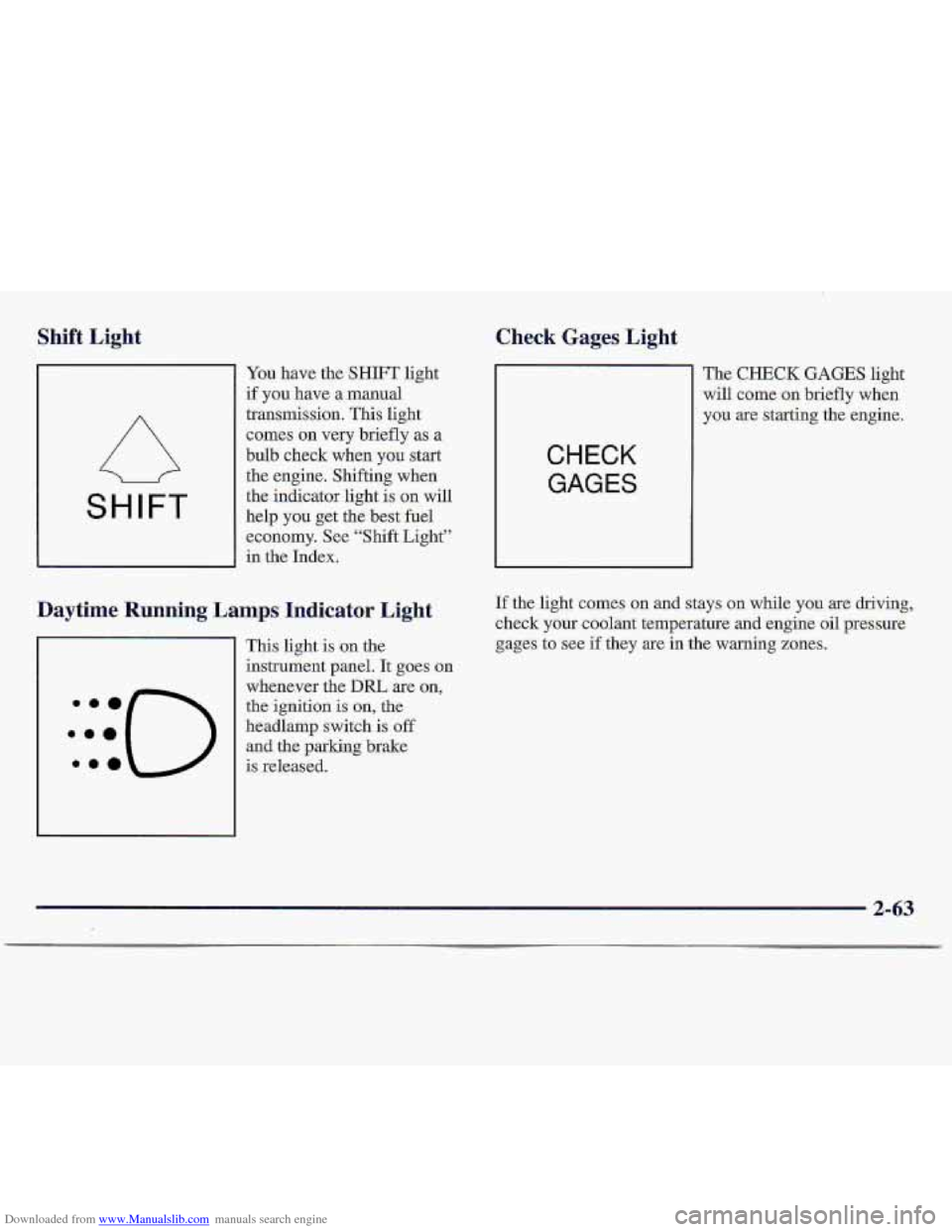
Downloaded from www.Manualslib.com manuals search engine Shift Light Check Gages Light.
SHIFT
You have the SHIFT light
if you have a manual
transmission. This light
comes- on very briefly as a
bulb check wh-en
you start
the engine. Shifting when
the indicator light is on will
help
you get the best fuel
economy. See “Shift Light”
in the Index.
Daytime Running Lamps Indicator Light
This light is ,on the
instrument panel. It goes on
whenever the
DIU are on,
the ignition is on, the
headlamp switch
is off
and the parking brake-
:::(-)
.ma is released.
CHECK
GAGES
The CHECK GAGES light
will come
on briefly when
y9u
are starting the engine.
If the light comes on and stays on while you are driving,
check
your coolant temperature and engine oil pressure
gages
to see if they are in the warning zones.
2-63
Page 133 of 402

Downloaded from www.Manualslib.com manuals search engine NOTXCE:
Before you add. any sound equipment .to your
vehicle -- like a tape player, CB radio, mobile
telephone
or two-way radio =- be sure you can add
what you want. If you can, it’s very important to
do it pruperly.-Added sound :equipment may
interferewith the operation of .your ve.hicle’s
engine, Delco;’ radio or other system-s, and -even
damage them.
Your vehicle’s systems may inteifere
Mth the opemtion of sound eq~pnent that has
heen added improperly.
So, befamadding sound equipment, check with
yo.ur dealer
and be sure to check. Federal rules-
coxering mobile .radib and telephone units.
e of Your Cassette Tape- Player
3-20
Page 144 of 402
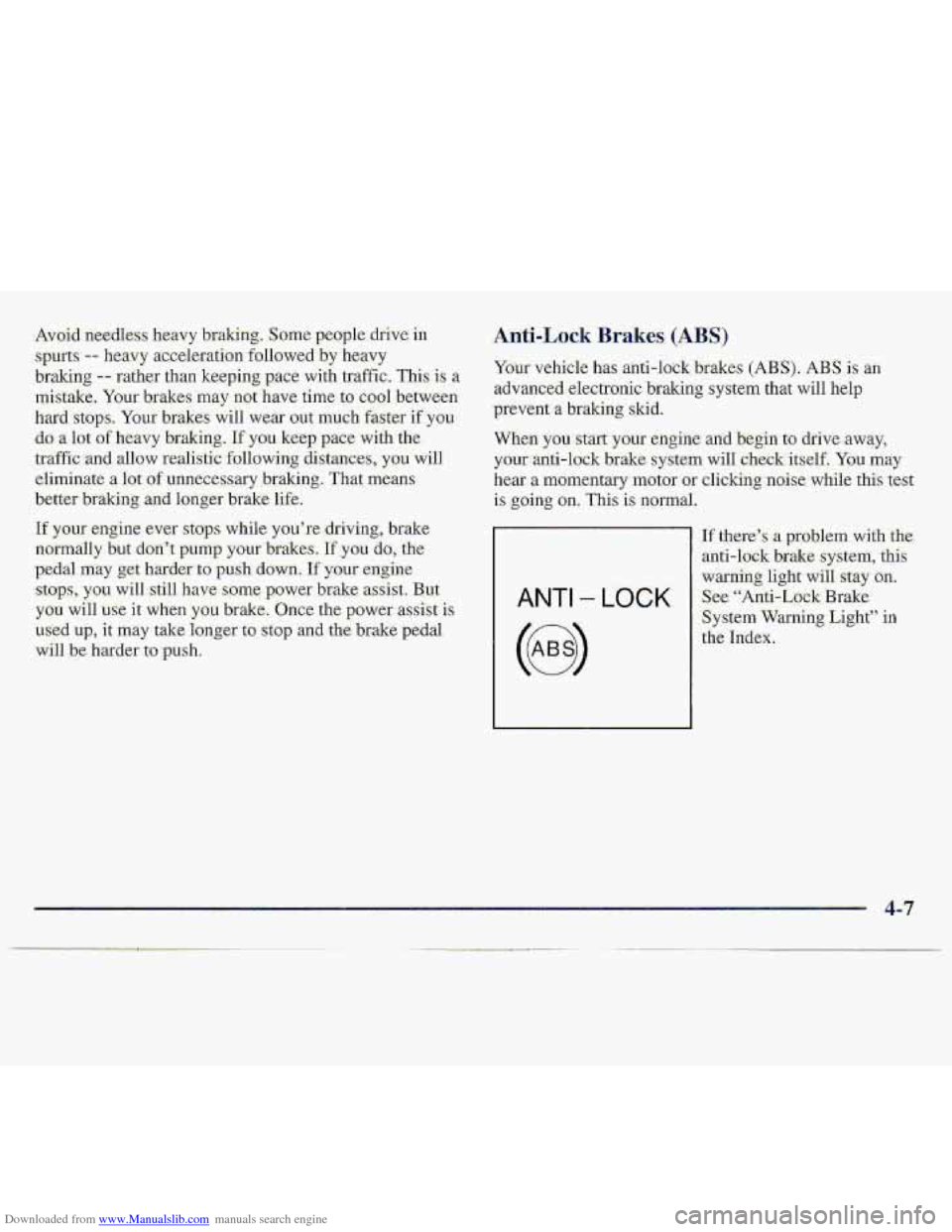
Downloaded from www.Manualslib.com manuals search engine Anti-Lock Brakes (ABS)
Your vehicle has anti-lock bmk& (ABS). ABS is an
advanced .electronic braking systeni that will help
prevent a braking skid.
When you start your engine and begin to drive away,
your-anti-lok
brake system will check. itself. Yau may
hear
a rnsrnentary motor or clicking-noise, w-file this ‘test
is going on. This is normal.
If your-engine ever stqs while you’se driving, brake
normally
but do;n’:t pul~ip your brakes. Ifyou do, th-e
,p%ed-al may get hard-er-to puGh .down. If -your.engi-ne
‘stops, you will-s~tal have some power assist. B:ut
you will a-se it when you brake; Once the power.asskt is
used up, it may take long-er to stop afid thelljrake pedal
will
.be .harder to zrush.
ANTI - LOCK
If there’s a problem with the.
anti-lock brake system, -this
war‘i&g.Iight will stay an.
See. “Anti-Lo& Brake
System
Warning Light” in
th.e Index.
4-7
Page 150 of 402
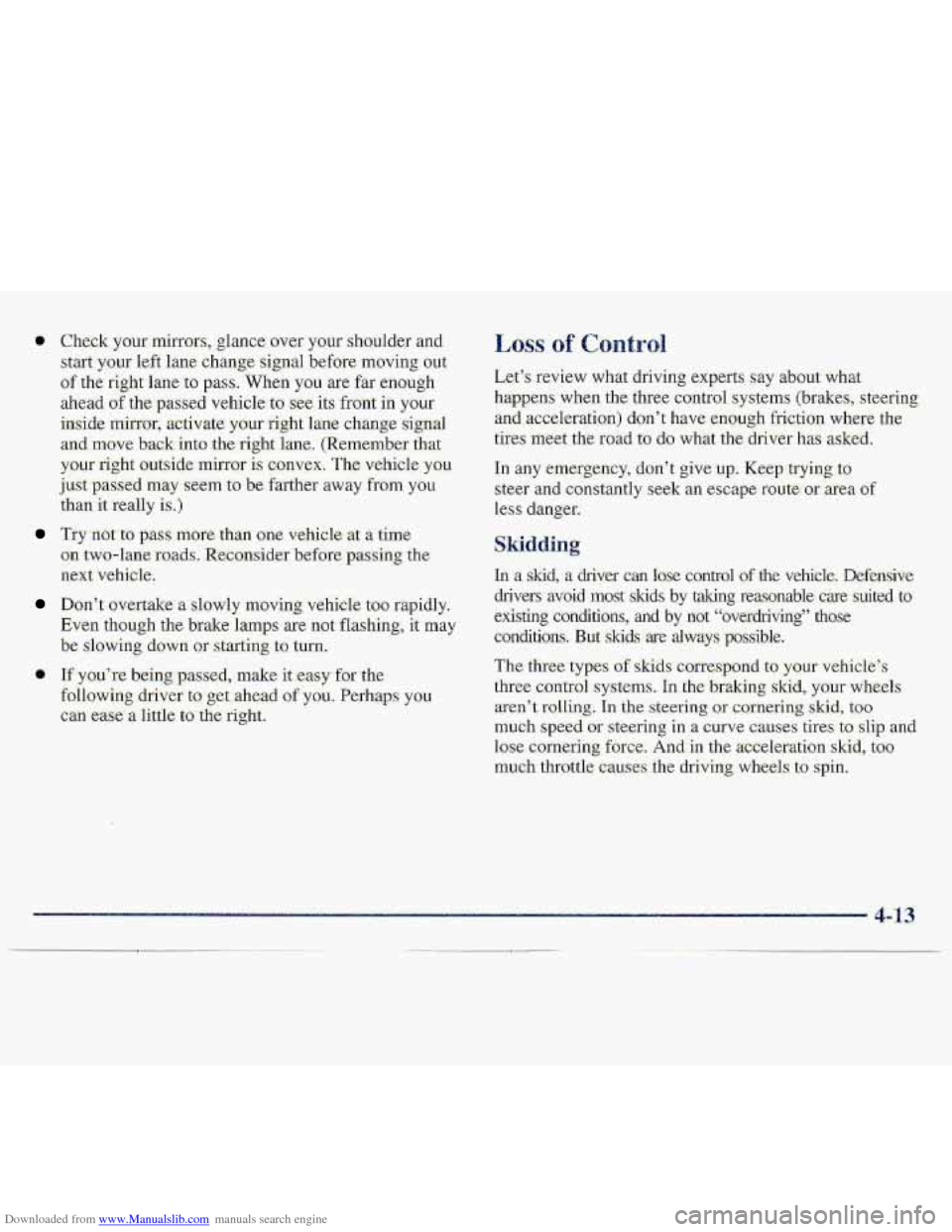
Downloaded from www.Manualslib.com manuals search engine * Check your mirrors, glance over your shoulder and.
start your left lane change
signal before-moving out
of the right.lane to pass. When you are far enough
ahead
of the passe.d vehicle to see its front in your
inside -01, activate your right lane change sigmd
and-move back into the.
ri,ght lane. (Remember that
your-right outside ,mirror is convex. The vehicle you
juslpassed may
seem to be farther away from y6u
than it really is.)
Tfy not co p.ass mufe ,than one vehicle ,at a time
on two-lane’roads. Reconsider before passing the
next vehicle.
D.on’:t overtake-.a slowly moving vehi-de too rapidly.
Even though
the brake -1amp.s are not flashing, it m.a.y
be slowing down or starting to, turn.
Qi If+ you’re being .passed, make it easy- for the
fallowing driver to
get..ahead .of you. Perh,aps you
can ease.&
little to the right.
Let’s review what driving expmts s-ay about what
happens when the thre.e
con.trol systems- (brakes., steering,
and,acceleration) don’t
have enough friction where the
tifes ”meet the road to do what the drivt?r has asked..
In any emergency, don’t give up Keep trying to
steer and constantly seek
an escape route-or aea of
less danger.
In a. skid, a driver cn lose control of .the vehicle, Defensive
drivers .avoid
most skids by taking reasonable care suited t9
existing conditiolrs, and by not “overdriving” those
conditions.. But- ,&ids
are always -pa.ssible.
The three typcis of skids correspond to your vehicle’s
three
c’0ntro1 syst,erns. In. the. brakifig skid, y0.m whe.eIs
aren’t rpl.ling. Ln the steering or- cornering skid, too
much speed or steering in a curve causes tires: to slip and
lase cornehg, foxce,. And. in the acceleration skid, too
much throttle causes the driving wheels- to spin.
4-13
Page 166 of 402

Downloaded from www.Manualslib.com manuals search engine After Off-Road Driving
Remove .any brush. or debris th.at has collected an. the-
underbQdy, chassis
or under the hood. These
accu.mulation-s
can be a fire hazard.
After
operation in mud or. sand, have the br&e linings-
cleaned -and checked. These substances can cause
glazing- and uneven braking,. C,heck tihe, body struc.ture,
steerbig, su$pensioonj
wheels, tires .-and exhaust system
for damage, Also, check the file1 lines and cooling
system for any leakage.
Your vehicle will req.uire more frequent service due to
aff-rrrad
use.. Refer to the Maintenance Schedule fo,r
additional infofmation.
.Driving at Night
Night driving is more dangerous th-an day driving. One
reason is that some drivers are likely to be impaire-d -.- by
alcohol or drugs, with nieht vision broblems, or by fatigue.
4-29
Page 171 of 402
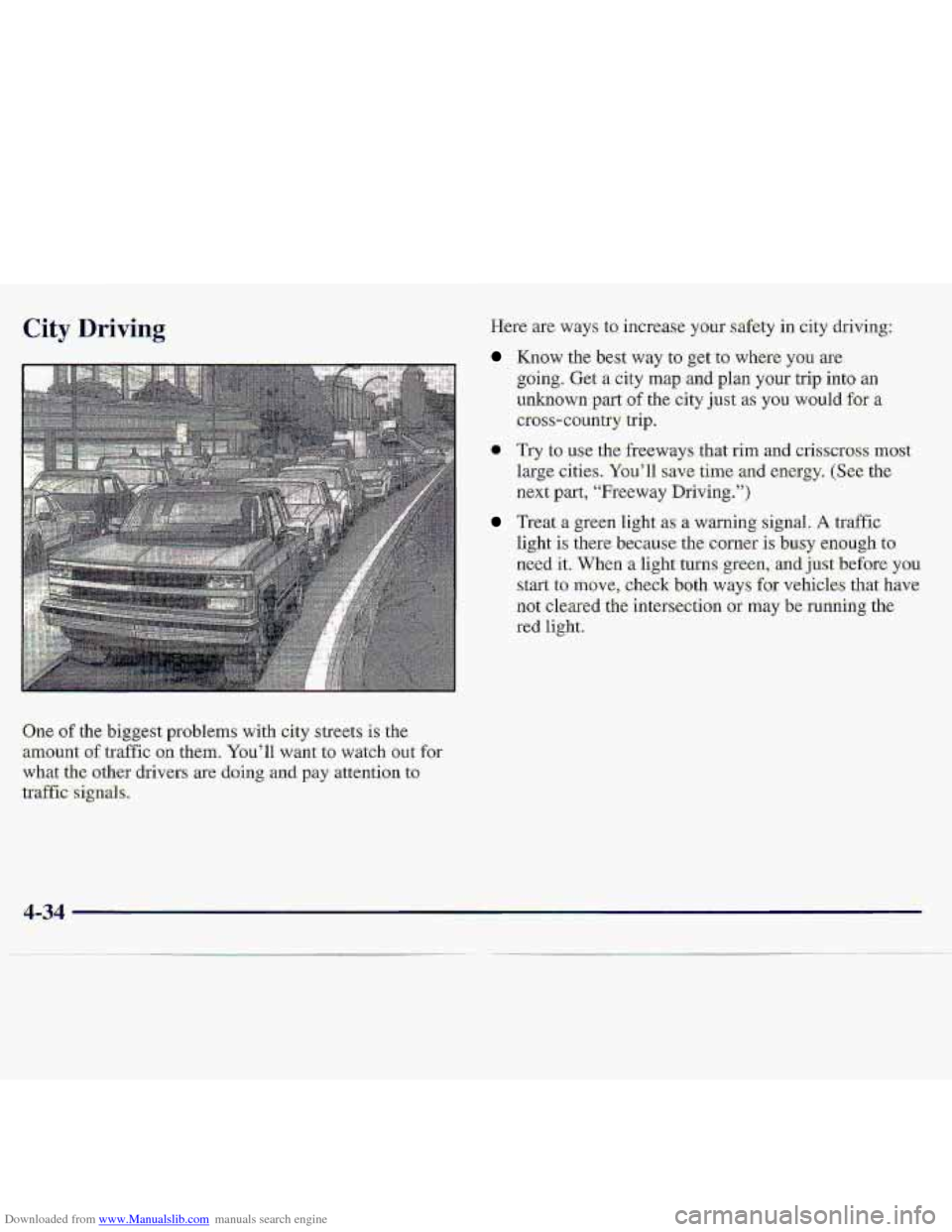
Downloaded from www.Manualslib.com manuals search engine C.ity Driving.
Orkof the bigg.est problems with city streets is the
:amount of traffic on them. You’ll want to watch o.ut for
what the other drivers are doing and pay attention to
traffic -.signals.
Here -are ways to increase y.ou safety in city driving.:
.Know the best way to get to where you are.
going, Get a city map and plan your trip into an
unknown part .of the city just as you wo.uld for a
cross-country trip.
m Try to use the freeways that-rim and.erisscr.oss mmst
large &tie-s. You’ll save time -and energy (See. the
next part, “Freeway Driving.”)
Treat a green light as a warning signal. A traffic
ligh.t-is there because the corner is busy emugh to,
need it. When a light turns gre,en, and just before you
start to Iimve, check both ways for vehicle-s that have
not cleared the intersection Or may be running the’
red li-ght.
4-34
Page 172 of 402

Downloaded from www.Manualslib.com manuals search engine Freeway Driving At the &irrance, there is usually a ramp that leads to the
freeway.
If you have a clear view of the freeway as you
drive along the entrance ramp, you should. be.gin to
check traffic. Try to determine where
you exp.e.ct to
blend with the flow. Try to merge iritd the gap at close to
the prevailing sp%eed. Switch on your turn signal, check
your mirrors and glance over your shoulder as often as
necessary. Try to blend smoothly with the, traffic flow.
Once
you are on the freeway, adjust youspeed to the
posted
limit or to the prevailing rate if it’%$Qwqq Stav
in the right lane uniess you want’to pass.
Before changing lanes, check y0u.r mirrors. Then use
your turn signal.
Just before you leave the-lane; glance. quickly over your
shoulder,
to make-sure there-isn’t another vehickin your
“blind” spQt.
Once you are moving
on the freeway, make certain you
allow a reasonable fdhwing distance. Expec-t to move
Mile fox mile, freeways (also called thruways, parkways, at night.
expressways, turnpikes or superhighways) are the safest
of-all roads. But they have- their own special rules,. When you want to leave the:freeway, move to the-proper
The most important advice on freeway-driving is: Keep under any circumstances, stop and back up, D~.~~ on to
up with traffic and keep to the right. Drive at the sam-e
s-peed .most of the other -drivers are dri.ving; Too-fast gr
too-dow driving. brek a smooth traffic flow. Treat .the The exit ramp can be curved, sometimes quite sharply.
left
lane on a fr-eeway as a passing lane. lane well
in advance. If you
miss your exit, do not,
the
next exit.